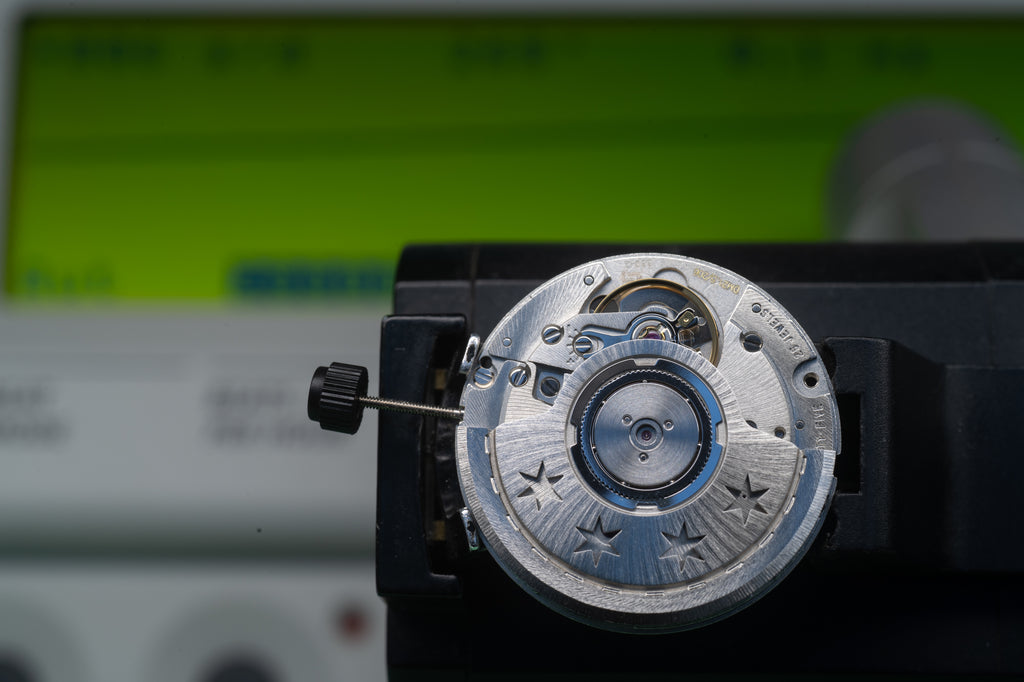FROM THE BENCH: What is Regulation?

Watches are useless if they don’t keep time, so how do we make sure that they’re accurate?
It’s a process called regulation, and it’s one of the most delicate adjustments that a watchmaker can make.
There are a few ways to regulate a watch, and Oak & Oscar watches use the most common mechanism, called a “regulator arm.” This time-tested method is highly adjustable, accurate, and robust. There are other ways to regulate a watch as well, but we’ll cover those in a different article.

Looking at the balance cock*, you can see the regulator arms extending out over the hairspring’s endcurve. That funny little screw near the +/- seems important, but it’s just a fine-adjustment mechanism. We’ll return to it shortly.
*Why “balance cock” instead of “balance bridge?” It’s a matter of historical convention. Bridges have to attach at both ends—and ours doesn’t. In fact, most watches have a balance cock, since the one-ended design takes up much less space in the movement, which is always at a premium.

There are two arms there, and they perform different functions. The arm holding the end of the hairspring is called the stud carrier, and it’s used to hold the hairspring steady. The other arm, with a tiny gold fork clipped into it, is the regulator, and that’s what we’re interested in.
These two arms are held in place by friction, and are adjusted—very carefully—with hand tools like tweezers. They’re pretty tight, but not fixed in place, so a good *WHACK* can nudge them slightly out of adjustment. That’s one reason why watches sometimes keep incorrect time: if they got banged around in shipping or after a big impact. That’s also why we worked so hard on the anti-shock mechanism in the Humboldt GMT!
Now, let’s get technical.

A watch’s timekeeping is determined by the length of its hairspring; the longer the spring, the slower the watch runs, and vice versa. The regulator arm functions as a dynamic limiter, effectively shortening the hairspring as it moves.
"Wait, what?"
Ok, the hairspring. It’s a spiral spring that expands and contracts as the balance wheel oscillates (learn more about mainspring mechanics here). Since the hairspring is fixed at the stud (the other arm), the spring will flex inwards and outwards during these contractions and expansions.

That little gold fork (called the regulator pins) on the regulator arm turns to make a wider or shorter gap around the hairspring. When the hairspring expands or contracts enough to contact the pins, they effectively shorten the hairspring’s length, making the watch run faster.
When the regulator is moved along the endcurve towards the stud, these contacts will happen on a longer part of the hairspring, and the watch will run slower. If the regulator is moved away from the stud, the contacts will happen on a shorter part of the hairspring, and it will run faster.

Likewise, if the regulator pins have a large gap, the hairspring will touch them less, and the watch will run slower. If the gap is tight, they will shorten the hairspring for more of its travel, making the watch run faster.
Simple, right?
If your head isn’t spinning, you’ll notice that the watch now has two rates—one when the hairspring is touching the regulator, one when it’s not. Since our watches beat at 8 Hz, that means it’s switching rates 16 times per second, 960 times per minute, 57,600 times per hour and 1,382,400 times per day. That’s complex! This is the downside of the regulator arm system, but it also has an upside.

As a rule, we try to leave the hairspring and balance wheel alone while they’re in motion. No touching. The less that they’re disturbed, the better and more accurately they can keep time. Regulator pins mean lots of touching, so the trick is to find a compromise between regulator pin width and regulator arm location.
The upside to this arrangement is that it’s easier to equalize rates between different positions—that is, the difference in timekeeping between when a watch’s dial is facing up and when it’s sideways. Because of gravity and friction, a watch doesn’t run as strongly on its side as when it’s dial-up. A weaker movement means less contact with the regulator pins, so a slower rate. If a watch is running too slowly on its side compared to dial up, the pins can be tightened, and the other way around.
So what about that little screw with the +/- markings?

That is simply a fine adjustment for the regulator arm. The “screw” is actually an eccentric pin, which imperceptibly nudges the regulator left and right to get an adjustment dialed in. Even tiny movements of the regulator, as small as 0.10 mm, the width of a human hair, can cause huge changes in the rate.
Instead of going mad trying to nudge the regulator into just the perfect spot, the fine adjustment allows a watchmaker to get a perfect rate once the regulator arm is placed pretty close to the target. Of course, we always try to get the timing perfect without the fine adjustment, but time is money and the option is there for a reason.
This is all complicated, and hats off to anyone who read this far! In the next article, we’ll discuss other ways to regulate a watch, including some historical examples from my Watchmaker’s Drawer of Wonders.
This is part one of a three-part series on regulation. Make sure and subscribe to our newsletter to get these stories sent directly to your inbox.
